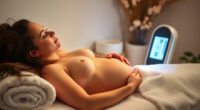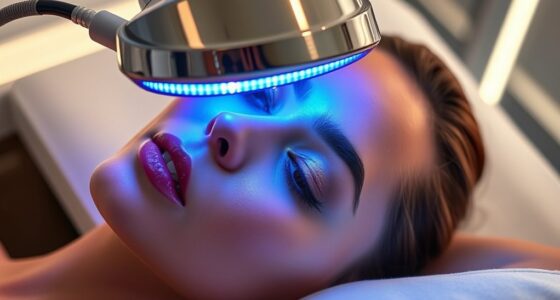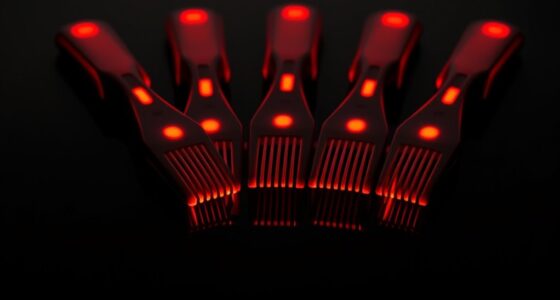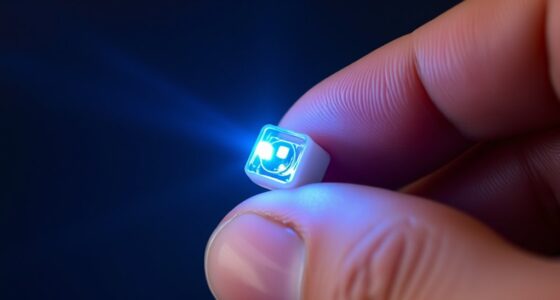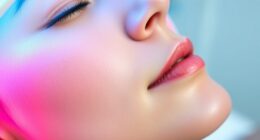Social media often promotes blue light therapy as a quick fix for breakouts, claiming it’s safe and effective for like-minded users. While some studies show it can help reduce bacteria and improve mild to moderate acne, results vary, and it’s not a miracle cure. Many influencers share their own successes, but significant scientific evidence is still evolving. If you want to understand how this treatment really works and whether it’s right for you, there’s more to discover.
Key Takeaways
- Social media endorses blue light therapy as a quick, safe solution for acne, but these claims are mostly anecdotal.
- Scientific studies support blue light’s effectiveness against acne-causing bacteria, especially for mild to moderate cases.
- Proper, consistent use and professional guidance improve results; overuse can cause skin irritation or damage.
- Blue light therapy is generally safe with minimal side effects, but individual reactions vary based on skin sensitivity.
- Social media hype often highlights best-case scenarios; real results depend on individual skin response and combined treatments.
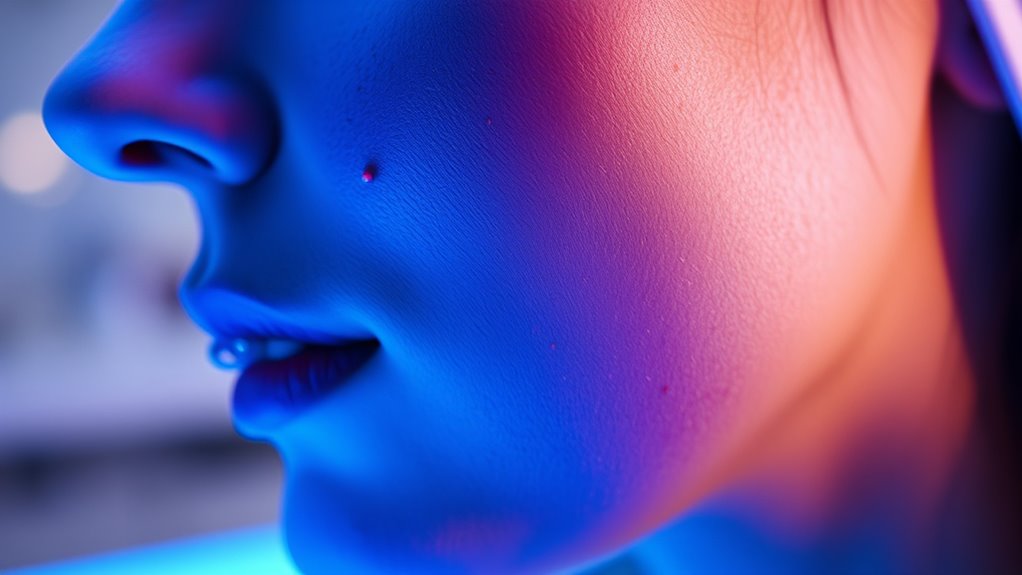
If you’re struggling with stubborn breakouts, blue light therapy might be worth trying. This skincare trend has gained popularity on social media, with many claiming it offers clear, blemish-free skin without harsh chemicals or invasive procedures. The idea is simple: blue light penetrates the skin and targets the bacteria responsible for acne, reducing inflammation and preventing future breakouts. But before you invest time and money, it’s essential to understand what science says about these claims.
Social media influencers often showcase blue light devices as quick and easy solutions for acne. Many users report visible improvements after just a few sessions, attributing their clearer skin to this technology. These testimonials, while compelling, are anecdotal and don’t replace scientific validation. The devices themselves are marketed as safe and non-invasive, with some claiming they can treat moderate to severe acne at home. Given the convenience, it’s understandable why people are curious. However, it’s vital to recognize that individual results vary, and not everyone experiences the same level of improvement.
Social media claims of quick fixes may not reflect typical results; individual responses vary.
From a scientific perspective, blue light therapy has some promising evidence supporting its use for mild to moderate acne. It works by targeting Propionibacterium acnes, the bacteria that contribute to breakouts. When exposed to blue light, these bacteria produce reactive oxygen species that kill them, reducing inflammation and the likelihood of new pimples forming. Clinical studies have shown that blue light can be effective, especially when combined with other treatments, but it’s rarely a standalone fix for severe cases. Also, the therapy’s effectiveness depends on consistent use and proper application, which some social media claims tend to oversimplify. Additionally, advances in AI-powered skin analysis are helping dermatologists customize treatments more effectively, improving outcomes for patients.
It’s important to think about safety as well. Blue light therapy is generally considered safe, with minimal side effects like temporary redness or dryness. However, overuse or improper use can cause skin irritation or damage, particularly if you have sensitive skin. Always follow product instructions carefully and consult with a dermatologist before starting any new treatment, especially if you have underlying skin conditions or are on medication.
Ultimately, blue light therapy might be worth trying if you’re looking for a non-invasive way to manage mild to moderate acne. Keep realistic expectations and remember that social media claims often highlight the best-case scenarios. Combining blue light therapy with a consistent skincare routine and professional advice can help you make the most of this treatment. But don’t forget, no single method works for everyone, and a tailored approach guided by a skincare professional will give you the best chance at achieving clear skin.
Frequently Asked Questions
How Does Blue Light Specifically Target Acne-Causing Bacteria?
Blue light targets acne-causing bacteria by penetrating your skin and activating a chemical called porphyrins within the bacteria. This activation produces reactive oxygen species that kill the bacteria, reducing inflammation and breakouts. You might notice clearer skin after regular treatments, as blue light specifically targets the bacteria responsible for acne without harming your surrounding skin. It’s a non-invasive, drug-free option that can complement your skincare routine effectively.
Are There Any Age Restrictions for Blue Light Acne Treatments?
You can generally undergo blue light acne treatments at any age, but it’s best to consult a dermatologist first. Usually, teenagers and adults benefit most, as the procedure is non-invasive and safe. However, if you’re under 12 or have specific skin conditions, your doctor might suggest alternative options. Always make certain the treatment is performed by a trained professional to minimize risks and get the best results.
Can Blue Light Therapy Be Combined With Other Acne Treatments?
Yes, you can combine blue light therapy with other acne treatments. It often works well with topical medications like benzoyl peroxide or salicylic acid, enhancing your treatment’s effectiveness. Just make sure to follow your dermatologist’s advice, as combining treatments may require adjustments to avoid irritation. Using multiple methods can help target different causes of acne, giving you clearer skin faster. Always consult your healthcare provider before starting combined therapies.
What Are the Potential Side Effects of Blue Light Therapy?
Like a knight facing a dragon, you might wonder about blue light therapy’s risks. You could experience temporary redness, dryness, or irritation after treatment. Some rare cases report mild eye discomfort if protective eyewear isn’t used properly. Overall, blue light therapy is gentle, but it’s essential to follow your dermatologist’s advice to minimize side effects. Keep your guard up, and you’ll be well-protected on your journey to clearer skin.
How Long Does It Typically Take to See Results From Blue Light Treatments?
You’ll typically start noticing improvements in your skin within 1 to 4 weeks of regular blue light treatments. Many people see a reduction in breakouts after about two weeks, but it can vary depending on your skin type and severity. Consistency is key, so sticking to your dermatologist’s recommended schedule will help you achieve the best results faster. Keep in mind, individual responses may differ.
Conclusion
As you turn off your screen and step into the quiet of your room, imagine blue light as a gentle lighthouse guiding you through the storm of breakouts. While social media claims sparkle like fleeting stars, remember that true skin health is built on consistent care and expert advice. Let this glow be a symbol of hope, not just a fleeting fix—your journey to clear skin is a steady voyage, not a quick flash in the night.

